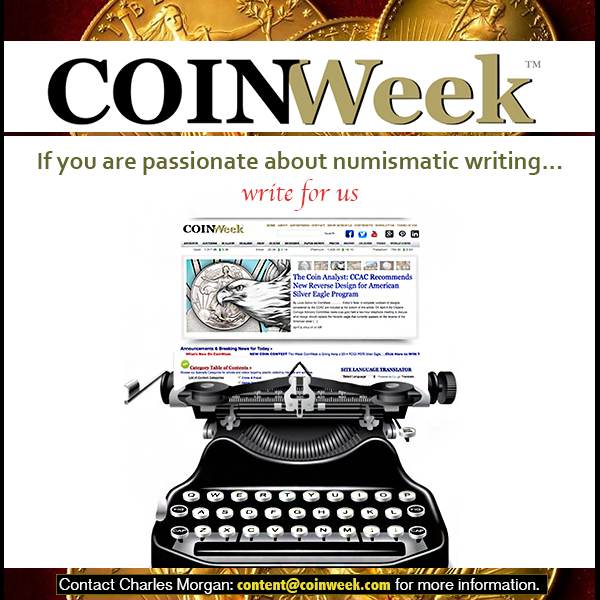
PREV ARTICLE
NEXT ARTICLE
FULL ISSUE
PREV FULL ISSUE
MORE ON SIBERIAN MINT MARKS
Steve D'Ippolito submitted these further thoughts on the Siberian pieces discussed in earlier E-Sylum issues. Thanks!
-Editor
I would like to thank Steve Bishop for spotting one very embarrassing goof in what I wrote. The regular-design Siberian coppers from 1781-1830 did indeed bear the KM mark, not the CM mark as I had written. He was correct on the mark, but I maintain he's not correct on the mint. [I apologize in advance to people who don't specialize in Russian Imperial numismatics; I am going to be throwing even more names you never heard before at you.] There was never a mint in Kolyvan. I know that many older books, including B. F. Brekke's work on Russian copper coinage (1977, and still the book on Russian imperial copper), make the claim that there was. I believed it myself. But later research has shown this to be incorrect. (I got to modify the text in one of my exhibits as a consequence, between the first time I showed it and the second time I showed it.) An article in the Summer 2003 Journal of the Russian Numismatic Society, authored by V. V. Uzdenikov of the Hermitage and translated into English, brings out the following. 1) The letters KM appearing on the Siberian-design pieces are not a mint mark. The evidence, document 121, as reproduced in Grand Duke Georgi Mikhailovich's Corpus volume on the coinage of Catherine the Great (hereafter: GM): "It is noted that the letters K.M on the ten [kopek] coin have the same meaning as the edge legend, i.e., Kolyvanskaya Med.' [Kolyvan copper.]" I should note that this is a quotation from a contemporary document reprinted in the Corpus (herafter, I will call it "GM.") Further--the edge inscription only appeared on pieces that have no KM mark, and vice versa. (Pieces smaller than 5 kopeks never had the edge inscription, but the KM letters were first used on original coinage in 1767. 1766-dated pieces with KM are novodels.) 2) There was no mint at Kolyvan; the mint was at Suzun, and was always at Suzun. Document 129 from GM indicates that the Siberian coinage was minted at a facility constructed in Suzun. Furthermore, Uzdenikov's 1992 general reference lists no mint in Kolyvan, neither does his book on the various Russian mints from 1995 (which as far as I know only ever appeared in Russian). Further indications come from (you guessed it) GM, this time document 129, which states that the Siberian coinage were constructed at a facility built in Suzun. (I was able to verify that the word Suzun appears in this document; but my Russian isn't good enough to be able to translate it, nor is the scan I have of that page of GM very legible in any case.) For reasons I don't understand, the Suzun mint continued to mark its coins with the letters KM even after it began producing regular-issue coppers in 1781 (as Steve pointed out). It finally changed over to CM in 1830, and the mint was finally shut down in 1847. Uzdennikov, in his 1992 reference, on pages 607 and 615 gives conflicting information on whether "KM" during this time period stood for "Kolyvan Copper" or "Kolyvan Coin." The latter would be a mint mark. Nevertheless, Uzdennikov insists in both of the works that I've mentioned that the mint was physically in Suzun, and is identical to the mint that used the CM mint mark from 1830 to 1847. Brekke mentions the "Kolyvan" mint having a fire during its initial construction, but (as it turns out) archival sources show that the fire was in fact at the Suzun facility! (Note: Uzdennikov's earlier edition from 1985 does indicate a Kolyvan mint operating from 1766 to 1801 [huh. Not 1830?], pages 448-449. Obviously he changed his mind.) OK, so why the confusion? I don't know for sure but I speculate that it stems from the fact that the Russian words for copper and coin both start with M. KM (standing for Kolyvanskaya Med') looks just like a mint mark. Indeed other contemporary coppers have marks like EM, AM, TM, MM and CM. As an aside, a different oft-repeated misconception that is also corrected in that same Summer 2003 JRNS article is that the copper was from a copper mine that had traces of silver and even gold in its ores; in fact the copper was byproduct of a silver mine, as I indicated. [In case anyone is wondering, A, T, M, and K in the Cyrillic alphabet are pronounced the same as in ours (though A is always "Ah", unless it's in an unstressed syllable, and never like the "long a" in "cake"). The C is pronounced like an S, always (unlike our C which might be pronounced like K), and the E is pronounced "Yeh" when it appears at the beginning of a word like "Ekaterinburg" but is roughly cognate to our "E." So the letters are pretty close to meaning what they look like they mean to our Western eyes.]
To read the earlier E-Sylum articles, see:

Wayne Homren, Editor The Numismatic Bibliomania Society is a non-profit organization promoting numismatic literature. See our web site at coinbooks.org. To submit items for publication in The E-Sylum, write to the Editor at this address: whomren@gmail.com To subscribe go to: https://my.binhost.com/lists/listinfo/esylum All Rights Reserved. NBS Home Page Contact the NBS webmaster 
|